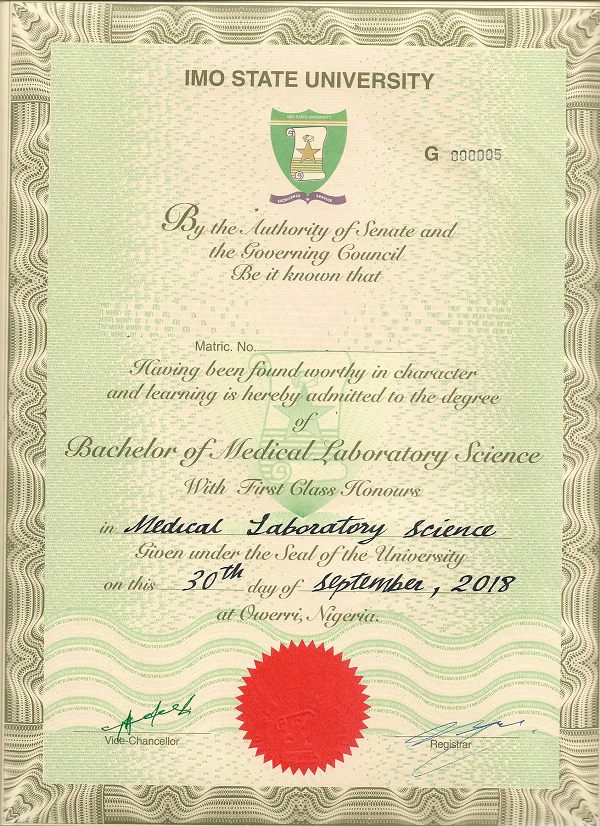Medical Laboratory Science
The Oculo/Visual Problems Associated With Artificial Eyelashes And Mascara Among Female Undergraduates Of Madonna University
ABSTRACT
This study was aimed at determing the oculo/visual problems associated with artificial eyelashes and mascara among female undergraduates of Madonna University. It was carried out in Madonna University Elele Campus, Rivers State. The study involves 93 female subjects between the ages of 18-25 years with mean age 21.5 ± 1.41(SD). Ocular history of eyelash fixing and mascara usage were extracted from the respondents through a well structured questionnaire. Data generated from this study was arranged in the excel spread sheet, and imported into the statistical Package for Social Sciences (S.P.S.S) version 16 and analyzed using charts and tables. From the study it was observed that the common oculo/ visual problems associated with artificial eye lashes in order of decreasing frequency include allergic conjunctivitis (21.5%, n=20), allergic blepharitis (16.1%, n=15), allergic blepharitis and allergic contact dermatitis (1.1%, n= 1). Common ocular/ visual challenges associated with mascara usage in order of decreasing frequency include allergic conjunctivitis (21.5%, n=20), allergic blepharitis (1I.8%, n=11), allergic blepharitis and allergic contact dermatitis (2.2%, n=2). The major reason adduced by the subject for fixing of artificial eyelashes and mascara usage include lack of severity of ocular problems (36.6%, n=34), followed by the need to look beautiful (34.4%, n=32) and the least common reason being that the ocular problems were not always present (29%, n=27), the motive behind continuation of practice despite obvious ocular/ visual challenges include the need to be attractive to the opposite sex (51.6%, n =48) and the least common motive adduced by participate was to increase self- esteem (20.4%, n=19). It was also observed that participants in the 18-21 years age group had a higher frequency of ocular symptoms (53.8%, n=50) compared with age group 22-25 years (46.2% n=43). The study concluded that artificial eyelash fixing and mascara usage results in oculo/ visual symptoms which is more with the younger ladies and the practice is continued with despite these eye challenges because of the need to look beautiful, and recommended the need for enlightenment campaign and awareness creation among ladies involve in the practice or about to embrace it.
CHAPTER ONE
INTRODUCTION
The eyelids are modified folds of the skin closing the front of the orbit which acts to protect the anterior surface of the globe from local injury. Additionally, they aid in the regulation of light entering the eye, in tear film maintenance, by distributing the protective and optically important tear film over the cornea during blinking and in tear flow, by their pumping action of the conjunctival and lacrimal sacs. The eyelashes which are found on the margin of eyelids, serve to protect the eye from foreign bodies. Eyelashes shed like other types of hair from the follicle. Each eye lash has its own cycle(anaphase) that lasts six to eight weeks so that most eyelashes are present to maintain their protective mechanism (Kuffor&Afari, 2012).
Artificial eyelashes (eyelash extensions) and mascara have become a cosmetic trend all over the world. Long lashes are considered a sign of femininity in many cultures and as a result some women seek to enhance their eyelashes length artificially, using eyelash extensions. False eyelashes can be used for thin or short eyelashes along with mascara to thicken the look of eyelash which creates a bold look (Gyanfosuet al., 2012).
Eyelashes extension could irritate the eyelid or clog follicles in the eyelid as well as pull out eyelashes during removal. The procedure does not allow frequent washing of the lids which results in bacteria or fungal infections seen as ocular discharge with conjunctivitis and eyelid disease. The eyelashes and mascara may also be displaced or mixed with sweat/water and serve as a foreign bodies/irritants to the eye. Also, because a bonding agent( glue) containing organic substances is applied near the eyes for the attachment of false lashes, allergic lid and conjunctival reactions could occur.
HISTORY OF FALSE EYELASHES
False eyelashes was first invented by the American film director D.W Giffith while he was making his 1916 epic, “intolerance”. Griffith wanted actress Seena Owen to have lashes that graced her cheeks, to make her eyes shines larger than life in a white and black film (Amano &Nishiwaki, 2012). A wigmaker wove human hair through fine guaze, which was then gummed to Owen eyelids. Since 1916, there have been plenty of leading ladies and celebrities who used false eyelashes. At first, false eyelashes were made of fringe. This is how false eyelashes history started. Fringe eyelashes were carefully attached to thread and by the means of glue this pattern was affixed to the eyelids. Obviously, these eyelashes failed to look natural; besides, the procedure was rather expensive, only famous people could afford it. Moreover, artificial eyelashes were not very noticeable. Years went by, new tendencies in false eyelashes were not that popular and it was supposed to fade out soon. However around 1950 the procedure became popular again after invention of plastic materials for lashes Sugimoto &sugita 2013) Applying false eyelashes by means of synthetics was promoted and film stars could not resist the burning desire to catch the audience´s attention by their magnificent eyelashes. False lashes become most popular in the 60s and then declined again. But in the late 2000s, with advancement in the material production, women have again begun to wear eyelashes more regularly to fill in or give the look of the fuller lashes. Models have often worn them, though, especially for photo shoots, to uphold certain standard of femininity that appeal to the fashion industry. Not everyone has thick, luscious lashes, but by adding false ones with exceptional care, everyone can look glamorous. People who have lost lash hair due to illness may also use false eyelashes. In 2006, Japan introduced lash by lash technique (individual small lashes). Each false lash was attached to each natural lash which looked at most naturally. The fringe was replaced by a material that looked like sable and mink´s fur. The lashes by lash has become extremely popular nowadays.
HISTORY OF MASCARA
Mascara is one of the most ancient cosmetics known, having been used in Egypt possibly as early as 4000B.C. Mascara has been applied since biblical times and today is the most commonly used eye cosmetic. The original mascara worn by women of ancient civilization was kohl, based on antimony trisulfide (Draelos, 2008). Egyptians kohl was probably made of galena or lead sulfite, malachite and charcoal or soot. The Babylonaians and ancient Greeks also used black eye comestics, as did the later Romans. Cosmetics of all sorts fell out of use in Europe after the fall of Rome, though eye cosmetics continue to be important in the Arab world (Antoet al., 2009). The use of cosmetics was revived in Europe during the Renaissance. Early mascara from the modern era usually took the form of a pressed cake. It was applied to the lashes with a wetted brush. The ingredients typically were 50% soap and 50% black pigment. The pigment was sifted and combined with soap chips, run through a mill several times, and then pressed into cakes. A variation on this was cream mascara, a lotion –like substance that was packaged in a tube. To apply it, the user would squeeze a small amount of mascara out of the tube onto a small brush (Draelos, 2008). This was a messy process that was much improved with the intervention in the 1960s of the mascara applicator. This patented device was a grooved application rod that picked up a consistent amount of mascara when pulled from the bottle. The groove rod was replaced with a brush. This new case of application may have contributed to the increased popularity of mascara in the late 1960s. The purpose of modern mascara formulation is to darken, lengthen and thicken the lashes.
OCULAR CONDITION ASSOCIATED WITH EYELASH EXTENSIONS AND MASCARA.
Eyelash extension and mascara are found to be associated with numerous ocular conditions; including keratoconjunctivitis, allergic blepharitis, conjunctival erosion, subconjunctivalhaemorrhage and traction alopecia.
KERACONJUNCTIVITIS
Keratoconjunctivitis is the inflammation of the cornea and conjunctiva. Keratoconjunctivitis usually presents ocular itching and irritation, and conjunctival hyperemia (redness) affecting prediominantly the lower region of the ocular surface. Eyelashes may give rise to keratoconjunctivitis by three mechanisms. The glue used for attaching the lashes which contain formaldehyde may directly invade the eyes during the procedure. It may also arise from indirect invasion hours after the procedure, when the glue dissolve as the patient washes her face, or when the glue is vaporised by body temperature, humidity or by the tear film . Conjunctival hyperemia in the lower region is attributed to the downward flow of lacrimal fluid from the gland to the lacrimal punta, and the specific gravity of formaldehyde being greater than that the lacrimal fluid (Lau &Riedi 2017).
ALLERGIC BLEPHARITIS
Blepharitis is the inflammation of the eye margin. Allergic blepharitis typically presents as redness, irritation, tearing and swollen eyelids affecting one or both eyes. The symptoms may not occur until hours or days after the eyelash extensions are applied. Formaldehyde in the glue and eyelid – fixing tapes are believed to cause allergic reaction. Lead and Benzoic acid, found in varying concentration in different brands of glue, are also suggested to be the cause in some patients.
TRACTION ALOPECIA
Traction alopecia refers to the condition where natural lashes are lost due to the action of synthetic lashes. It may induce further damage to the eyelash follicle, resulting in the stunted hair eyelash growth and the less common include allergic contact dermatitis which occurs as a result of allergic reaction after being exposed to foreign substances. This causes the body to release inflammatory chemicals that can make the skin itchy and irritated example include perfumes or chemical in cosmetics and skin care products.
1.1 STATEMENT OF THE PROBLEM
The fixing of artificial eye lashes and use of mascara is a trend that is widely embraced by middle aged and young ladies, including female undergraduate in Nigerian universities. Despite the delicate nature of the eye and its adnexia and ocular discomfort associated with artificial eyelashes fixing and mascara usage, the practice has not only continued but has expanded in scope. This practice can now be seen among teenagers and grandmothers. A good number of women who have taken to the practice of artificial eyelashes fixing and mascara usage temporally or repeatedly did so out of ignorance of the likely harm that will cause to the eye. It is surprising to note also that those who have experienced some ocular challenges due to artificial eyelashes and mascara usage have held on to the practice for reason best known to them. This study attempted to find out the oculo visual disorders associated with artificial eye lash and mascara usage and the reason behind the persistence of their practice with the aim of creating societal awareness among ladies who are involved in the practice, those contemplating taking up the practice as well as ladies who never thought of embracing the practice. It has been understood that many oculo-visual problems observed among young and middle aged ladies are usually cosmetic induced (especially artificial eyelash and mascara) which may lead to other ocular complications. In the eye section of Madonna University Teaching Hospital in Elele, many cases of itching, hyperemic conjunctiva and inflamed eye and eyelids were brought to the hospital. From questioning, majority responded positively to the use of mascara and artificial eyelash especially on a regular basis. This gives the possibility that some chemicals and preservatives which are used in the production of most mascara could trigger an allergic reaction when used by some individuals.
-
PURPOSE OF STUDY
The goal of this study was to find out the types of ocular / visual problem associated with artificial eyelash fixing and mascara application among female adult in Nigerian universities.
-
OBJECTIVES
- To find out the frequency and type of ocular challenges (symptoms and signs) associated with artificial eyelashes fixing among young female adults.
- To ascertain the frequency and types of ocular / visual challenges associated with mascara application among young ladies.
- To find out the motives behind the fixing of artificial eyelashes and mascara application among young ladies.
- To find out the reasons behind the continuation of the this practice despite seeing ocular (eye) issues.
- To find out if the practice of fixing artificial eyelashes and mascara application among young adults is associated with age.
-
RESEARCH QUESTIONS
- What are the types and frequency of ocular / visual challenges (symptom and sign) associated with the fixing of artificial eyelashes among young female undergraduates of Madonna University, Nigeria Rivers State?
- What are the types and frequency of ocular / visual challenges associated with mascara application among young ladies?
- What are the motives behind the fixing of artificial eyelashes and mascara application among young ladies?
- What are the reasons behind the continuation of the this practice despite seeing ocular (eye) issues?
- Is the practice of fixing artificial eyelashes and mascara application among young adult associated with age?
-
SIGNIFICANCE OF STUDY
The significance of this study is derived from the benefits the findings would have in contribution to the pool of literature that is currently available on the subject matter. Finding from this study can be used to create awareness and help to educate ladies on the issues associated with the practice of fixing artificial eyelashes and mascara application. Individuals can employ findings from their everyday decision making with regards to facial make-ups and other cosmetics applied to structures of the eyes.
1.6 LIMITATIONS OF STUDY
Some of the oculo-visual symptoms and sign presented by the participants could not be independently verified while some of the complaints have resolved as at the time of carrying out the study.
Pages: 47
Category: Project
Format: Word & PDF
Chapters: 1-5
Material contains Table of Content, Abstract and References
-

 IMSU News4 years ago
IMSU News4 years agoIs It Worth Registering a Pre-degree Program In IMSU? All you need to know about IMSU Pre-degree
-

 IMSU News5 years ago
IMSU News5 years ago7 Popular department in Imo State University (IMSU)
-

 IMSU News2 years ago
IMSU News2 years agoIMSU reprinting for 2023/2024 post UTME candidates has commenced
-

 IMSU News4 years ago
IMSU News4 years agoSteps on How to Apply for Certificate in Imo State University, Owerri (IMSU)

